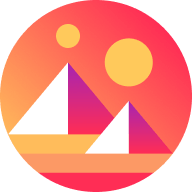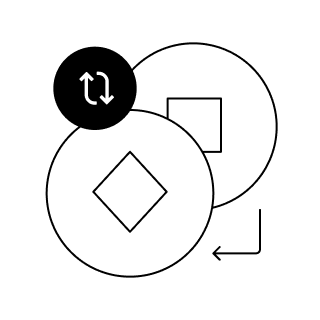What’s Decentraland (MANA)? How can I buy it?
What is Decentraland?
Decentraland is a decentralized, user-owned virtual world built on the Ethereum blockchain where people can buy, develop, and monetize parcels of virtual land. Launched to the public in February 2020 by the Decentraland Foundation, it blends social experiences, gaming, art, and commerce within a persistent 3D environment. The platform is governed by a decentralized autonomous organization (DAO), allowing MANA and LAND holders to vote on protocol-level decisions, content moderation policies, marketplace fees, and ecosystem grants.
Two primary crypto assets underpin Decentraland’s economy:
- MANA: An ERC-20 token used for purchases (wearables, names, services), DAO voting power (when wrapped as wMANA), and previously for land sales. MANA can also be burned or locked in certain transactions and proposals, affecting supply.
- LAND: Non-fungible tokens (NFTs, originally on the ERC-721 standard) representing ownership of 16m x 16m parcels within Decentraland’s map. LAND can be combined into Estates. Ownership grants control over the content and experiences deployed to that parcel.
Decentraland’s vision is an open metaverse where creators and users—not centralized platforms—capture value from digital experiences, assets, and social interactions.
How does Decentraland work? The tech that powers it
Decentraland is architected as a layered system, separating consensus/ownership from content distribution and real-time interaction:
- Ownership layer (on-chain)
- Blockchain: Ethereum secures the registry of LAND ownership and the MANA token. LAND parcels and Estates are NFTs; transfers and auctions are recorded on-chain.
- Marketplace and assets: Wearables, names, and LAND are traded via smart contracts. Wearables typically follow ERC-721/1155 standards and include metadata pointing to 3D models and textures stored off-chain.
- DAO governance: The Decentraland DAO manages protocol parameters, grant funding, and certain contracts. Voting weight derives from wMANA (MANA deposited into the DAO), LAND, and Estate holdings.
- Content and deployment layer (off-chain, decentralized)
- Content servers (Catalyst network): Scene content (3D models, scripts, and metadata) is deployed to decentralized servers known as Catalysts. Anyone can run a Catalyst; the DAO maintains the allowlist.
- IPFS-style content addressing: Assets are referenced by content hashes, making the system resistant to tampering. When a LAND owner deploys a scene, they publish content to Catalyst nodes, which pin and serve it to clients.
- Real-time communications layer
- P2P and server-assisted networking: The client connects to a set of Catalyst services for presence, voice chat, and messaging. Positioning and state synchronization utilize peer discovery and region-based interest management to reduce bandwidth.
- Rendering client: Users access Decentraland via a web client (WebGL/Three.js stack) or desktop client. The client loads the parcel’s scene graph, assets, and scripts, and renders them locally.
- Creator tooling and scripting
- SDK: Decentraland’s SDK (TypeScript/JavaScript) lets creators script interactive scenes, games, NPCs, and monetization logic. Scenes are deterministic and run client-side, with authority coming from ownership of the parcel and deployed content.
- Builder tool: A no-code/low-code interface for assembling scenes with drag-and-drop assets, useful for creators who don’t want to write code.
- Wearables and emotes: Creators can submit wearables/emotes for curation and minting, then sell them on the marketplace. Metadata includes rarity tiers and linked 3D models.
- Economy and monetization
- Transactions: Most transactions use MANA, though marketplace contracts may support ETH as well depending on integrations. Fees and burns can be governed by the DAO.
- Business models: LAND rental, ticketed events, brand activations, advertising, play-to-earn game loops, and marketplace sales. Ownership and composability allow third-party services (lending, rentals, analytics) to integrate without permission.
Security, scalability, and decentralization considerations:
- Ethereum mainnet finality secures ownership. Gas costs for heavy interactions can be mitigated by batching and off-chain content.
- Off-chain content distribution via Catalysts reduces on-chain bloat while preserving integrity through content hashing.
- Governance decentralization through the DAO reduces reliance on the Foundation, though practical decentralization depends on voter participation and token distribution.
What makes Decentraland unique?
- User-owned virtual land at protocol level: Unlike centralized metaverse platforms, LAND ownership is blockchain-enforced. Owners control deployment without a gatekeeper.
- DAO-driven governance: Policies for content moderation, fees, and grants are community-managed, aligning incentives with users and creators.
- Web-first, open stack: No proprietary engine lock-in; assets are IPFS-addressed, and anyone can run Catalyst servers. This fosters resilience and forkability.
- Mature creator economy: Early mover advantage with curated wearables, emotes, names, and event infrastructure has attracted brands, artists, and communities.
- Interoperable standards: Use of ERC-20/721/1155 and off-chain hashing enables broader composability with DeFi (e.g., collateralizing NFTs) and other Web3 services.
Decentraland price history and value: A comprehensive overview
Note: Prices are volatile and subject to rapid change. Always verify current data with reputable sources.
- Early phase (2017–2019): Decentraland’s initial LAND auction and MANA token sale took place in 2017. MANA traded at low single-digit cents for an extended period as the platform and tooling matured.
- Public launch and growth (2020–2021): Following the 2020 public release, activity gradually increased. In 2021, metaverse and NFT narratives surged, catalyzed by mainstream interest. MANA reached all-time highs in late 2021 amid broad market exuberance.
- 2022–2023 bear market: Like most crypto assets, MANA retraced significantly during the broader market downturn. Fundamentals continued to evolve, with DAO grants, events, and creator tools improving despite lower token prices.
- 2024–2025 context: The metaverse theme remains cyclical. Price action has been influenced by macro liquidity, risk appetite, and the relative traction of competing virtual worlds. On-chain metrics (active users, land transactions, marketplace volume) and DAO activity can provide a more nuanced view of value than price alone.
Value drivers:
- User growth and retention: Daily active users within scenes, event attendance, and session time.
- Creator economy vitality: Sales volume of wearables/emotes, number of new submissions, and brand partnerships.
- LAND market health: Parcel turnover, rental activity, and development density in popular districts.
- Governance and treasury: Effective allocation of grants and iterative improvements in platform tooling and moderation.
- Broader Web3 cycle: Liquidity conditions and narratives (NFTs, gaming, metaverse) that can amplify or dampen interest.
Risks:
- Competition: Other virtual worlds and gaming platforms, both Web3 and Web2, vying for creators and users.
- UX and performance: Browser-based rendering constraints, onboarding friction (wallets, gas), and hardware diversity.
- Governance participation: Concentrated voting power or apathy can slow decision-making or skew incentives.
- Regulatory uncertainty: Treatment of tokens and NFTs across jurisdictions.
Is now a good time to invest in Decentraland?
This is not financial advice. Whether it’s a good time depends on your risk tolerance, time horizon, and thesis on open metaverse adoption.
Consider the following framework:
- Product traction: Evaluate real usage rather than headlines. Check Decentraland’s event calendar, map density, creator submissions, and marketplace volumes. More organic activity can underpin sustainable value.
- Token mechanics: Understand MANA’s utility (purchases, governance), issuance, burns, and treasury dynamics. Assess how demand for wearables, names, and LAND translates to MANA velocity and potential sinks.
- LAND vs. MANA exposure: LAND offers direct exposure to virtual real estate (and potential rental income) but is less liquid and more idiosyncratic. MANA is more liquid and diversified across the ecosystem’s activity.
- Governance effectiveness: Review the DAO proposals, voter turnout, and grant outcomes. Effective governance can accelerate improvements and ecosystem growth.
- Competitive landscape: Compare Decentraland’s tooling, performance, and community with other metaverse and gaming projects.
- Portfolio sizing and risk: Crypto assets are highly volatile. Use position sizing, dollar-cost averaging, and risk controls appropriate to your financial situation.
Actionable due diligence tips:
- Explore the world: Join events, test the client performance on your device, and assess creator quality firsthand.
- Review on-chain data: Look at LAND sales, unique buyers/sellers, and MANA on-chain activity via reputable analytics dashboards.
- Read DAO forums and proposals: Gauge roadmap alignment, treasury health, and grant efficacy.
- Check third-party audits and repositories: Validate the openness and maintenance of the SDK, client, and Catalyst software.
In sum, Decentraland remains one of the earliest and most decentralized attempts at a user-owned virtual world. Its long-term value will likely track the depth of its creator economy, the stickiness of its social experiences, and the DAO’s ability to evolve the platform in a competitive and rapidly changing environment.
Discover the different ways to buy crypto in the UAE
Create an OKX account
Get verified
Start a trade
Enter an amount
Choose your payment method
Confirm your order
All done
Create an OKX account
Get verified
Start a trade
If Decentraland isn’t available in the dropdown, purchase any of the available tokens and convert it to MANA.
Place a buy order
Complete your purchase
Receive your MANA
All done
Get the OKX app or Wallet extension
Set up your wallet
Fund your wallet
Find your next purchase
Note:
Tokens with the same symbol can exist on multiple networks or may be forged. Always double-check the contract address and blockchain to avoid interacting with the wrong tokens.
Trade your crypto on OKX DEX
Choose the token you’re paying with (e.g., USDT, ETH, or BNB), enter your desired trading amount, and adjust slippage if needed. Then, confirm and authorize the transaction in your OKX Wallet.
Limit order (optional):
If you’d prefer to set a specific price for your crypto, you can place a limit order in Swap mode.
Enter the limit price and trading amount, then place your order.
Receive your crypto
All done

Make informed decisions


How to get Decentraland for free
See what you can do with your crypto
How to buy Decentraland (MANA) FAQ
Disclaimer
You are viewing content that has been summarized by AI. Please be aware that the information provided may not be accurate, complete, or up-to-date. This information is not (i) investment advice or an investment recommendation, (ii) an offer, solicitation, or inducement to buy, sell or hold digital assets, or (iii) financial, accounting, legal or tax advice. Digital assets are subject to market volatility, involve a high degree of risk, and can lose value. You should carefully consider whether trading or holding digital assets is suitable for you in light of your financial condition and risk tolerance. Please consult your legal/tax/investment professional for questions about your specific circumstances.














